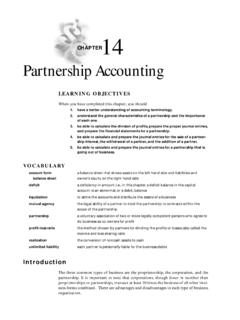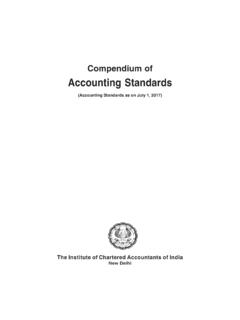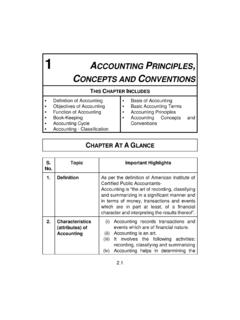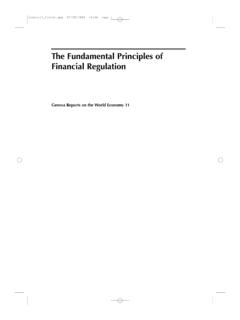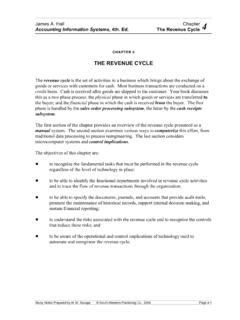Transcription of Financial Accounting - Tutorialspoint
1 Financial Accounting Financial Accounting i About the Tutorial This tutorial will help you understand the basics of Financial Accounting and its associated terminologies. Audience This tutorial has been designed to help beginners pursuing education in Financial Accounting or business management. Any enthusiastic reader with basic mathematics knowledge can comprehend this tutorial. After completing this tutorial, you will find yourself at a moderate level of expertise from where you can take yourself to next levels.
2 Prerequisites Before you start proceeding with this tutorial, we assume that you have a basic understanding of commerce. Copyright & Disclaimer Copyright 2014 by Tutorials Point (I) Pvt. Ltd. All the content and graphics published in this e-book are the property of Tutorials Point (I) Pvt. Ltd. The user of this e-book is prohibited to reuse, retain, copy, distribute or republish any contents or a part of contents of this e-book in any manner without written consent of the publisher. We strive to update the contents of our website and tutorials as timely and as precisely as possible, however, the contents may contain inaccuracies or errors.
3 Tutorials Point (I) Pvt. Ltd. provides no guarantee regarding the accuracy, timeliness or completeness of our website or its contents including this tutorial. If you discover any errors on our website or in this tutorial, please notify us at Financial Accounting ii Table of Contents About the Tutorial .. i Audience .. i Prerequisites .. i Copyright & Disclaimer .. i Table of Contents .. ii 1. OVERVIEW .. 1 Introduction .. 1 Definition of Accounting .. 1 Objectives and Scope of Accounting .. 2 Accounting Process .. 2 Accounting Process.
4 3 Accounting 5 Accounting Conventions .. 9 Classification of Accounts .. 11 Accounting Systems .. 12 2. Financial Accounting .. 15 Journal .. 15 Analysis and Treatment of Transactions .. 16 Posting in a Ledger .. 21 Ruling of Account in Ledger Account .. 22 3. SUBSIDIARY BOOKS .. 26 Cash Book .. 26 Triple Column Cash Book .. 28 Petty Cash Book .. 28 Purchase Book .. 28 Sale Book .. 29 Financial Accounting iii Purchase Return Book .. 29 Sale Return Book .. 29 Bills Receivables Book .. 30 Bills Payable Book .. 30 Key Features of Subsidiary Books .. 30 Bank Reconciliation.
5 31 Trial Balance .. 32 Financial Statements .. 33 Owner s Equity .. 34 Current 34 Current Liabilities .. 35 Depreciation .. 35 4. COST Accounting .. 38 Definition of Cost Accounting .. 38 Concepts of Cost Accounting .. 38 Advantages of Cost Accounting .. 41 Cost Accounting versus Financial Accounting .. 43 Classification of Cost .. 45 Elements of Cost .. 48 Cost Control and Cost Reduction .. 49 Tools and Techniques of Cost Reduction .. 53 5. COSTING TECHNIQUES .. 55 Marginal Costing .. 55 Standard Costing .. 57 Variance Analysis .. 58 Cost-Volume-Profit Analysis.
6 62 Break-Even Chart .. 65 Financial Accounting iv 6. MANAGEMENT Accounting .. 67 Definition .. 67 Characteristics of Management Accounting .. 67 Objectives of Management Accounting .. 69 Management Accounting versus Cost Accounting .. 71 Cash Flow .. 72 7. RATIO ANALYSIS .. 83 Accounting Ratio .. 83 Accounting Analysis .. 83 Ratio Analysis and its Applications .. 83 Advantages of Ratio Analysis .. 84 Limitations of Ratio Analysis .. 84 Types of Ratio .. 85 Chart of Useful Ratios .. 88 Working Capital .. 94 8. BUDGETING 97 Definition .. 97 Budget, Budgeting, and Budgetary Control.
7 97 Types of Budgets .. 98 Flexible Budget v/s Fixed Budget .. 100 Flexible Budget .. 101 Cash Budget .. 102 Financial Accounting v This chapter covers the following topics: Definition of Accounting Objectives & Scope Accounting Process Accounting Concepts Accounting Conventions Classification of Accounts System of Accounting Rules of Double Entry Accounting System Introduction Accounting is a business language. We can use this language to communicate Financial transactions and their results. Accounting is a comprehensive system to collect, analyze, and communicate Financial information.
8 The origin of Accounting is as old as money. In early days, the number of transactions were very small, so every concerned person could keep the record of transactions during a specific period of time. Twenty-three centuries ago, an Indian scholar named Kautilya alias Chanakya introduced the Accounting concepts in his book Arthashastra. In his book, he described the art of proper account keeping and methods of checking accounts. Gradually, the field of Accounting has undergone remarkable changes in compliance with the changes happening in the business scenario of the world.
9 A bookkeeper may record Financial transactions according to certain Accounting principles and standards and as prescribed by an accountant depending upon the size, nature, volume, and other constraints of a particular organization. With the help of Accounting process, we can determine the profit or loss of the business on a specific date. It also helps us analyze the past performance and plan the future courses of action. Definition of Accounting The American Institute of Certified Public Accountant has defined Financial Accounting as: the art of recording, classifying and summarizing in a significant manner and in terms of money, transactions and events which in part at least of a Financial character and interpreting the results thereof.
10 1. OVERVIEW Financial Accounting vi Objectives and Scope of Accounting Let us go through the main objectives of Accounting : To keep systematic records: Accounting is done to keep systematic record of Financial transactions. The primary objective of Accounting is to help us collect Financial data and to record it systematically to derive correct and useful results of Financial statements. To ascertain profitability: With the help of Accounting , we can evaluate the profits and losses incurred during a specific Accounting period. With the help of a Trading and Profit & Loss Account, we can easily determine the profit or loss of a firm.










